|
Uniforms for volunteers were not on immediately supply, at first
armbands with LDV on them were all that were available, and then there were not always
enough to go around. The official issue, when it could be distributed, was steel helmet,
service jacket or denim overall, and a service or forage cap. When these were eventually
delivered those who got items to fit were the lucky ones. As weapons were not allowed to
be carried without the armband being worn it was important that when going off duty men
left theirs behind for those coming on duty to wear and thus qualify for a weapon. Not
that these were always available either. Some men, farmers for example, might have eased
the shortage situation by bringing along shotguns they owned, others hunting rifles etc.
Stories of pikes and broom handles being used in other parts of the country are
apparently not without foundation. As already stated, a limited number of p14 rifles
were available to Redhill and Reigate men. Unfortunately there was no guarantee that the
possession by Home Guard units of rifles ensured the possession of suitable quantities
of ammunition for them as this was also in very short supply. One activity for which
some sort of ammunition supply had to be available for was rifle training, which in
Redhill/Reigate's case was carried out at a local range (see later note regarding
location). The early patrols carried loaded weapons but experience of accidents
involving men not used to handling weapons prompted a ruling that when on patrol with a
rifle five rounds was to be carried in the pocket. The rifle was only to be loaded when
the man encountered the
enemy.
Other weapons used were molotov cocktails, which had been proved useful against tanks in the Spanish Civil War. Groups of volunteers were formed into bomb squads and trained in their manufacture and use. It ought to be said that against a fully armed invasion force the volunteers were a little lightly equipped, to say the least, and it has been recorded that their spirit was superior to their weaponry.
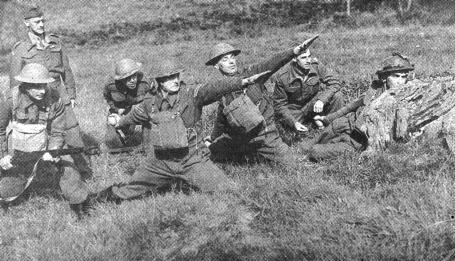 |
9 |
Practice at grenade throwing.
(
picture courtesy Peter Pringle) |
By July 1940 organisation was fairly complete, with a
mobile HQ also set up and motorcyclists being trained as
dispatch riders. The Battle of Britain began on July 10th 1940 and created new and
real activities for the Home Guard in the shape of spotting enemy parachutists and
guarding vulnerable installations that were receiving special attention from the
Luftwaffe.
Home Guard training was not just in the use of rifles but in small arms generally, including grenades, and in fieldcraft. This involved concealment and camouflage, the spotting of a concealed enemy (perhaps in the form of snipers), and in moving about without being seen or apprehended, and in capturing enemy parachutists who also wanted to avoid being seen. It also involved learning how to react and escape when under fire.
|
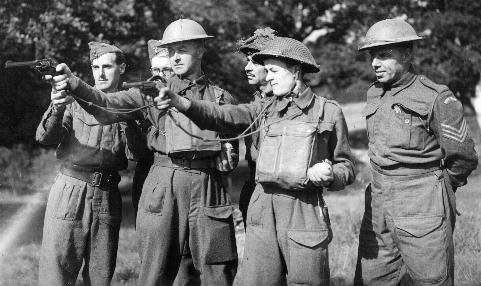 |
| 10 |
Here two men are under revolver tuition. It looks very unconvincing.
The sergeant has his knife and fork sticking out of his tunic pocket as if he’s off to lunch as soon as the photo has been taken. Both pupils have one eye closed. The four apparent tutors heavily outnumber pupils. How can the man on the left adjust the arm position of the pupil as though he can see better down the length of the barrel? If this photo was taken for publicity purposes it would lower moral among the population at large rather than raise it.
On the back of the picture is written: ‘right to left, Mr Littlewood, (the sergeant?) Pup Hemsley, (the younger aimer?) Phillip Bennett (with the moustache?) Mr Hemsley (2nd aimer?). The aimer on the right seems to be the same man who was the overpowered guard in picture 7 on the left. The man at the back of the group with just his face showing seems to be the camouflaged man 2nd from left in picture 2 above, and does still have some on his helmet.
(
picture courtesy Peter Pringle)
| |
|
|
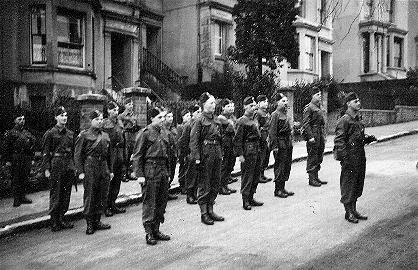 |
| 11 |
Lt Pringle lived in Upper Bridge Road, Redhill, and part of his house was given over as the Home Guard HQ.
Here the 8th Battalion of the Surrey Home Guard is drawn up in the road outside his house The house was no.8, Holmleigh (not in picture as the men are facing it) and was next to no.6, Apsley, the house that was bombed.
As platoon leader Mr Pringle made his house the platoon HQ.
A Mr Murphy recollected in an article in the Surrey Mirror of December 7th 1989 that the house was 'more like an army barracks than a house, with uniforms and men going around the place every day'.
Presumably this meant that much of the equipment required by the platoon was kept there and operations started from there.
(picture courtesy Peter Pringle)
|
| |
|
|
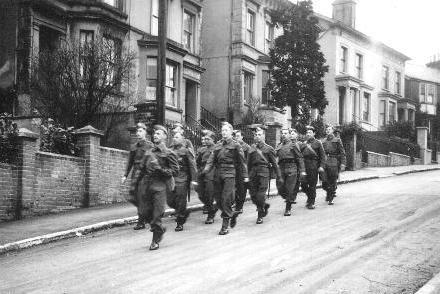 |
| 12 |
The platoon marching down Upper Bridge Road, Walter Pringle leading. (Possibly as the start of the stand-down parade- see below)
(
picture courtesy Peter Pringle)
Author's note: As author of this website it is a little strange to look at these pictures for I lived only a few houses down from Mr Howe Pringle on the same side of Upper Bridge Road from 1939 to 1951 yet knew nothing of any Home Guard activities during the war years. Admittedly I was very young, being only six years old in 1945, but my mother remembers no Home Guard activities either, although she remembers Mr Pringle. If anyone has any memories of any of the Home Guard activity in Redhill or Reigate I would be pleased to hear from them.
| |
|
|
|
Weekend camps and proficiency testing, both more than
reminiscent of scouting activities, were additional tasks undertaken by Home Guard men.
In fact scouts of suitable age must have been in their element here, and suitable age
usually meant fit and willing and between 14 and 70, although the official age limit was
18-65. In June 1941, boys of 17 were accepted as cadets into the Home Guard and units of
boys aged 12-18 affiliated with a view to replaced some of those called up. Any early
relaxation of the age rule was ended by the end of 1941, however, and perhaps accounted
for the decline in membership that stared around this time, although another reason
apart from the transference to the regular army was movement to other Civil Defence
organisations. It ought to also be noted that the National Service Act of December 1941
also made some form of National Service compulsory, making all those between 18 and 51
liable to be conscripted into the Home Guard, which now lost its voluntary
status.
One of the problems faced by the Home Guard early on could well have been a lack of credibility attributable to men who only practised at war while the real fight went on elsewhere. Bureaucracy and age was against them as was the interruption they caused to the relatively tranquil lives of many civilians away from the areas receiving specific enemy attention. As we now know invasion never came but none of them knew then what we know now and so lived with the very real possibility that their acquired skills might well be required in earnest. After all, the enemy was gathered in strength only just across the English Channel.
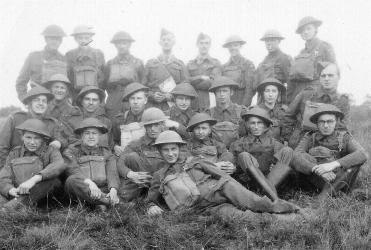
|
14 |
As mentioned at the beginning of this section, many of the
trainers were skilled in one or more of these activities, either through having
received intensive training themselves or through having been in the armed forces
before the war. Indeed, some members of the Home Guard were veterans of other wars,
such as WW1 or the Spanish Civil
War. Training included the use of manuals and Government films but was taken beyond the pure learning stage and into the experience stage with the setting up of exercises that simulated 'invasion-type events. Probably all created new experiences for many of the men although some were designed to test official procedures as well as Home Guard preparedness. Weaknesses could be identified and remedied this way. Mistakes could be made in practice rather than when it really mattered than none were made at all.
The Redhill platoon under the command of Capt Howe Pringle, who is 4th from the left in the back row.
(picture courtesy Peter Pringle) |
| |
|
|
|
Another re-organisation was that of the Area Group
into six Companies as below: -
|
| Company | Commander |
| |
| A | Capt. W.Hill
2 i/c Major Scott |
| |
| B | Lt. A.Dewar
2 i/c Lt.Col. E.James |
| |
| C | Capt. John Gibson
2 i/c Mr W.Jeffcock |
| |
| D | Capt. E.Mansfield
2 i/c Major Strickland |
| |
| E | Capt. W.Charlesworth
2 i/c Capt. D.J.Smith |
| |
| F | Capt. C.H.Austin
2 i/c Lt-Col. Stowell |
| |
As time went by the
activities and skill requirements of the Home Guard were expanded more and more.
Communication skills ranged from despatch riders on motorcycles to radio operators.
Combat skills included street fighting and house clearance, as well as town and village
defence. In Spring 1942 they also included the manning of anti-aircraft batteries
following the transfer of 50,000 home based regulars abroad. With bombing, and later V1
and V2 activity, rescue and first-aid was also a part of Home Guard
duty.
In addition to general units of Home Guard there were those formed by factories, utilities and other companies. These included gas and electricity companies, the GPO, railway and bus companies. The East Surrey Water Company had its own unit at Reigate looking after its interests there, as did the Reigate bus garage. The Southern Railway had thousand of miles of track carried over thousands of bridges and viaducts, all vulnerable to attack and essential for continued communication, so it also had its own Home Guard units and benefited from their specialised as well as local knowledge. Redhill and Reigate railwaymen belonged to the 2nd Southern Railway Battalion, some of whom formed a light AA unit that saw action against the flying bombs.
|
|
In September of 1944 it was advised that the
Home Guard would be disbanded at the end of December. If this seems rather early it must
be remembered that by this time, with Allied occupation of Europe under way and the
Germans in retreat the war had taken a turn in Britain's favour and invasion was no
longer a real threat. Nevertheless many members were disillusioned with the way the
disbandment was handled. Some had been working eighteen-hour days in order to old down
full-time jobs and carry out their Home Guard duties. Some had taken to their tasks with
such gusto that a new way of life that suited them very well had suddenly come to an
end. As a result some members left before the official stand down at the end of the
year. On the other side of the coin there were no doubt those to whom the compulsory
attendance was an intrusion on their lives and they welcomed the ruling.
The final parade of the Surrey Home Guard took place in Croydon on December 1st 1944.
The Stand Down parade of the 8th Surrey (Reigate) battalion was a few days later.
The men marched from the County School to the Odeon, Redhill, via London Road, High Street, Church Street and the main road to Redhill. The ceremony at the Odeon began with a service conducted by the vicar of St Luke's, South Park. This was followed by a speech from the Mayor in which he congratulated the first contingent of the armed forces to be demobilised. He added that they should have no regrets about not going into action against a ruthless enemy, quoting Milton's great line; 'They also serve who only stand and wait'. Additional speeches were made by Sir Leslie Burnett and Col. Hake.
|
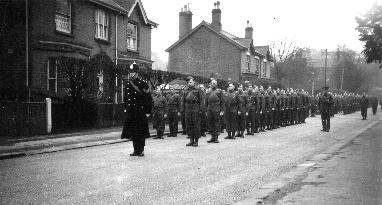
15
|
|
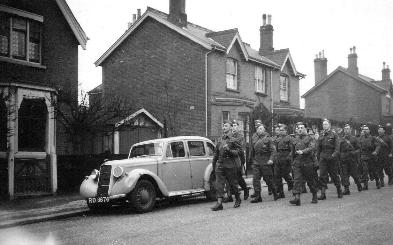
16
|
|
The Home Guard on the march. This may not be the stand-down parade but a parade on another occasion
(
pictures courtesy Peter Pringle)
|
| |
|
|
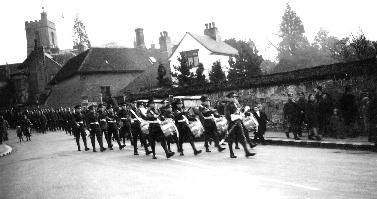
17
|
|
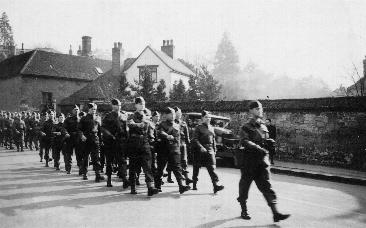
18
|
|
First the band then the batallion in Chart Lane, Reigate, with Walter Pringle at its head.
(pictures courtesy Peter Pringle)
|
| |
|
|
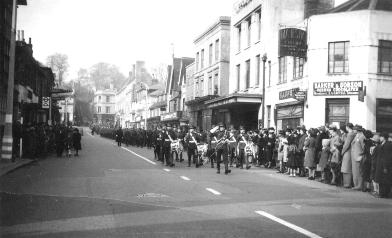
19
|
|
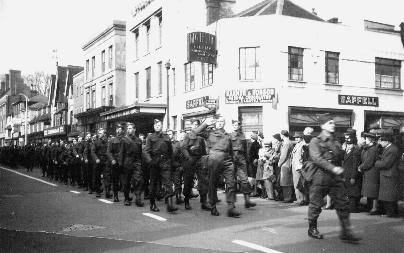
20
|
|
The parade in Bell Street, Reigate. Unfortunately we are unable to see who is taking the salute
(pictures courtesy Peter Pringle)
|
| |
|
Memories of Mr M.Pringle, son of Walter Pringle mentioned above |
|
After the Home Guard had disposed of its Pike and
Pitchfork image, a consignment of 1914/18 Ross 300 calibre rifles arrived from Canada in
their protective grease. A chap called Jackson who had some electrical ability and
myself cleaned the rifles ready for use. Some folk, including Walter Pringle, still had
their service revolvers from the 1914-18 war. Some even had uniforms which scarcely fitted
them and were covered in the ravages of moths.
As a 14-year old home from public school for the summer
holidays I wore an LDV arm band and journeyed on my cycle between Redhill Company HQ
(Redhill Football Club Offices) and Battalion HQ in Reigate. Redhill had Major Mansfield, an
ex-colonial administrator, and Captain Strickland, a retired army major who took a drop in
rank. In the battalion were a number of distinguished officers from the first war; Lt Col
Dudley Lewis DSO MC; Lt Col Young MC, and Captain Bickell, who wore RFC wings.
1940 brought the Battle of Britain and with it the
indiscriminate bombing of Redhill and Reigate. Our house in Upper Bridge Road, Redhill, had
a bomb in the front garden. The house survived but the house next door was in flats and was
declared a dangerous building. Occupants the Udales were safe and were rehoused opposite.
Amongst the local Home Guard were a number of workers from
the Monotype works at Salfords and Harold Stanley, a barristers clerk in the Chambers of
Ronald Ainstey Jones QC (Princess Margaret’s father-in-law). Harold bore a mustard gas scar
on his forehead, a reminder of gas attacks in WW1. He lived built a Humber Snipe in good
cellar.
One figure who liked to play with his ammunition was Lt
Wally Rands, a fellow with lots of explosive expertise which he put to good use in
training.
The field craft school was opened in 1943 at the old
Bletchingly golf course. Members of the Home Guard from far and wide attended the courses at
weekends, often sleeping under canvas.
The threat of a summer invasion was fading and the
replacement threats were the V1 flying bomb and the V2 rocket, Hitler’s secret weapon. No
one could do anything about the V1 rockets save that the RAF paid frequent visits to
Peenemunde where they were developed. The rocket sites were in Holland Belgium and on the
French coast.
I was particularly friendly with Sid Bish. He had
one eye and worked at Negretti & Zambra Scientific Instruments. Sid was killed when a V1
rocket fell on houses in Earlswood.
The field craft school under the guidance of Walter
Pringle was relocated at Shagbrook, Buckland, an isolated country mansion with extensive
grounds opposite the Buckland sandpits. We had a lot of fun at Shagbrook; Humphrey Harvey
and myself slept under the stars after a visit to the Jolly Farmers. We entertained the
Merstham Division of the ladies Home Guard and took them out on patrol. (What has happened
to Effie Charlesworth?). We had live ammunition and dummy hand grenades that exploded like
fireworks. We had a lot of fun throwing them into the Buckland sandpit lake.
|
| |
|
|
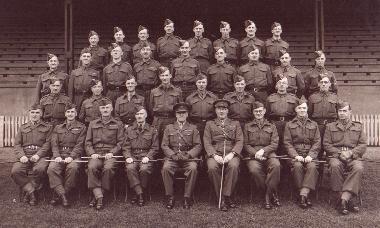
21
|
|
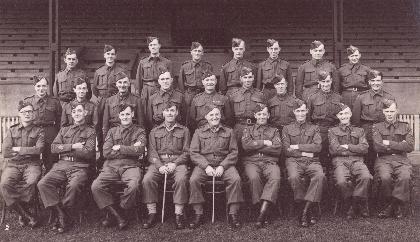
22
|
|
A photo of a Home Guard Platoon taken at Redhill Sportsground, probably after the stand-down parade. Nothing is known about this group.
(picture courtesy Roy Styles)
|
|
This is 13th Platoon, D Company, also at the Sportsground and again taken probably after the stand-down parade. On the bottom of the picture is written 'In appreciation of loyal service. Good luck!' It is signed by W.Bush and C.Lawrence. The man far right of the front row is Herbert William Henson.
(picture courtesy Roy Styles)
See enlargement below)
|
| |
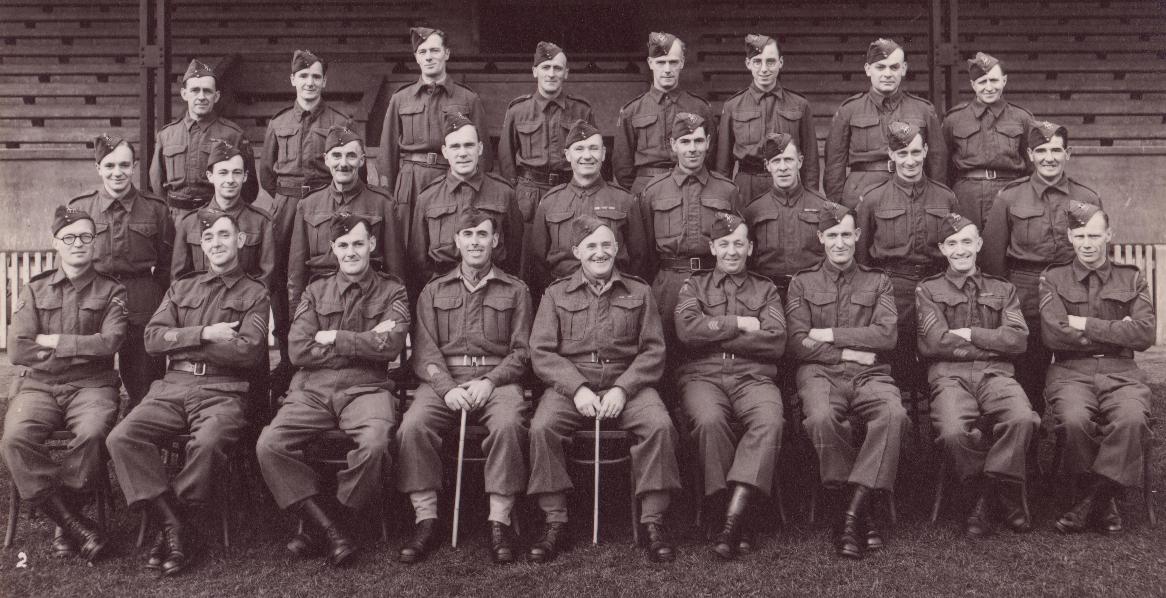
23
|
|
This is the same photo as in 22 above but as I can now identify
more of the people in it it is worth reproducing here. Those now known are: -
Front Row from left - 1. Patrick Bracken, North St., Redhill (Identified by Jean Charman) 2. unknown 3 Mr Bleach (Identified by Peter Hyder) 4 Charlie Lawrence (Identified by Alan Buckland) Will Lawrence (Peter Hyder) 5. W.Bush 6. William Buckland (identified by Alan Buckland) 7. Frederick James Gurdin of Colesmead Rd, Redhill (identified by Valerie Palmer) see more information below. 8. unknown 9 Herbert William Henson.
Middle row from left - 1. Mr Dolman, chemist at Reffells Bridge (identified by Peter Hyder) 2. Mr Molton (identified by Peter Hyder) 3. unknown 4. unknown 5. unknown 6. unknown 7. Mr Barker (identified by Peter Hyder) 8. unknown 9. unknown
Back row from left - 1 unknown 2. Jack Wheatley, Manager of International Stores (identified by Peter Hyder) 3. unknown 4. Mr Barnett, builder Fengates Road (identified by Peter Hyder) 5. unknown 6. Fred Akehurst, North St., Redhill (identified by Jean Charman) see also email below. 7. Bert Neale, Manager Dewhurst Butchers, Redhill (Identified by Mr Heaseman of Bletchingly) 8.
unknown
|
| |
More about Frederick Gurdin (email from Valerie
Palmer)
I can identify, as can my mother, her
father and therefore my grandfather, who is Frederick James Gurdin of 14 Colesmead
road, Redhill. He had six children, Ronald, Geoffrey, Robert k/a Bobby, Maurice and daughter
Joyce Lillian Gurdin (who married a Gordon k/a Don Slade) and Phyllis Gurdin was the
youngest. Frederick is the third person from the right in the front row in photos 22
and 23.
Fred as he was known as was a Sergeant in
the home guard unit. He was a talented carpenter and musician in the Reigate Silver Town
Band and could turn his hand to most wind instruments. He unfortunately had an accident and
died aged 44. All but one of his children are still alive. Fred's parents lived in Monson
Road, Redhill. He was married to Lillian Ethel Grace Holland k/a Lilly. My
mother's brother Archibald Holland was married to Helen Bashford and lived in
Garden Row Redhill, and he was in the 8th Army part of the desert rats. Throughout the
war, Helen worked in a munitions factory, the Monotype at Salfords, and she lost her
brother on HMS Hood.
Another family memory my mother has told us all
is the day that the doodle bug went over her house in Colesmead rd , when she was out in the
garden, it was so low huge and had a terrible roaring sound as it went past. She dropped to
the ground and it roared past above her, then she thought it would crash into trees in the
bottom of her road , but travelled on to Merstham, where it landed beside Merstham station,
onto a builders yard, where Mr Bashford, my mothers aunt Helen's father, was working and he
was killed outright. It was obviously heading for the railway line/station. My mother
believes the event happened around mid-day.
The family was not well off, as her father was
always in and out of hospital with his foot injury which ended up with him having his leg
off in 1951 and it went gangrerous and he died about six months afterwards. As he was in and
out of hospital so frequently he made a huge wooden dolls house for the children’s ward at
the East Surrey Hospital one Christmas. We do have a photo of this but not of him.
Another memory from my mother concerns photo 15
above. My mother believes this was the standing down parade and her father Fred
Gurdin, Sgt, was marching on the outside of his group, on his own alongside, but the photo
is too unclear to say that the man in the photo doing this was him or his group, but she
thinks it is. she and the family watched the parade proudly and followed it into Bell St
Reigate.
Regards, Valerie Palmer nee
Slade |
| |

24 |
|
Another splendid photo of a Home Guard platoon, also taken in the Redhill Memorial Sportsground. It was sent in by Graham Stacey who says that his Grandfather, Fred Greenfield of Wilton Road, Redhill, is 3rd from the left in the 2nd row back. As with the previous photos, if anyone can make any other identifications of men in this photo they will be gratefully received. Many thanks to Graham Stacey for sending it in to be included here.
The following identifications received January 2009 from Ron and Joan Stacey
Front row L- R 1st Mr Wright shoe repair shop, Brighton Rd. 2nd Mr Graves of Graves Coaches Brighton rd. 4th Major Jones. 7th Arthur Powell Knighton Rd.
Second row L-R 8th Ernie Dewey. 9th Jim Grey of Victoria Rd. 10th Frank Cook of Redstone Rd.
Back Row L-R Jim Osborne shoe repair Emlyn Rd next to Bristows Garage
.
And another received May 2009 from Alan Hall
I am contacting
you with regard to the Home Guard picture no. 24 on your history page.The gentleman
in the back row, fourth from the left looking at the photo, was my grandfather,
William Daniel, who lived in Knighton Road, Earlswood, at the time. He was born in
1890 which means he was in his fifties and I believe he used to work as a lorry
driver, but cannot recall who he worked for. Hope this information is of some
assistance to you.
Home guard pict 24 front L R 1st Mr Wright shoe repair shop
Brighton Rd 2nd Mr Graves graves coaches brighton rd 4th Major Jones 7th
Arthur Powell Knighton Rd 2nd row LR 8th Ernie Dewey 9th Jim Grey Victoria Rd10th
Frank Cook Redstone Rd Back Row LR Jim Osborne shoe repair Emlyn Rd next to Bristows
Garage hope this helps. Best wishes, Ron
|
|
Email from Phil and Robina Wiggs - Back in June this year we wrote to
the Surrey Mirror because we thought we identified one of the men in the picture of
a Home Guard group. I don't know if that information was passed on to you. I now
see that in photo 23 on your excellent web site he is identified as Fred Akehurst,
number 6 in the back row. My wife and I had thought it could, just possibly, be Francis
Wood, who had fish shops in Redhill and Reigate, maintaining the one
in Lesbourne Road Reigate until he retired around 1970. He was a
firearms instructor in the Reigate Home Guard, so could be the person
whose face is only just showing behind the man holding a revolver on
the left of picture 10. He does look as if he is taking a more pragmatic view
of what the gunman is doing. However we are now not at all sure! He lived at the time at
20 Chartfield Road Reigate, which was a comparatively new house at the time, having
been built in the mid thirties. Fascinated by your web site and particularly in the
Home Guard elements. We hope the above might be of some interest, although
we stress that we cannot positively identify Frank.
|
| |
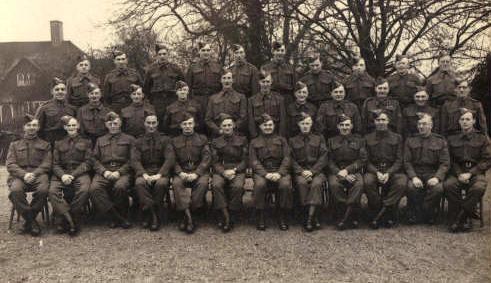
25 |
|
Above and below are two more photos of Homeguard, both supplied by Leanne Fagan. Picture 25 above is untitled and her great grandfather, Frederick James Fagan, third on the right in the front row. The location has been identified by Philip Watford as the main house at 'Shagbrook', Reigate. Many thanks to Leanne and Philip.
|
| |
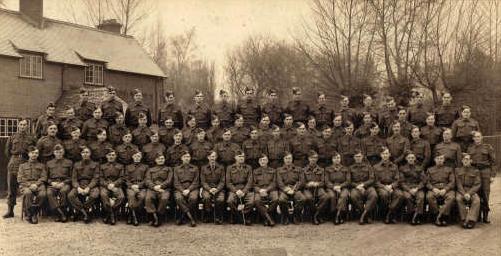
26 |
|
Picture 26 (the larger group) is titled 'E Company, 8th Batallion, Surrey Home Guard, December 1944'. The only person identified is again Frederick James Fagan, who is 3rd from left in the front row. The location here is unknown. Picture supplied by Leanne Fagan.
|
| |
|
|
Pat Hodnett from Canada contacted sent in some documents received by her family during and after WW2.
|
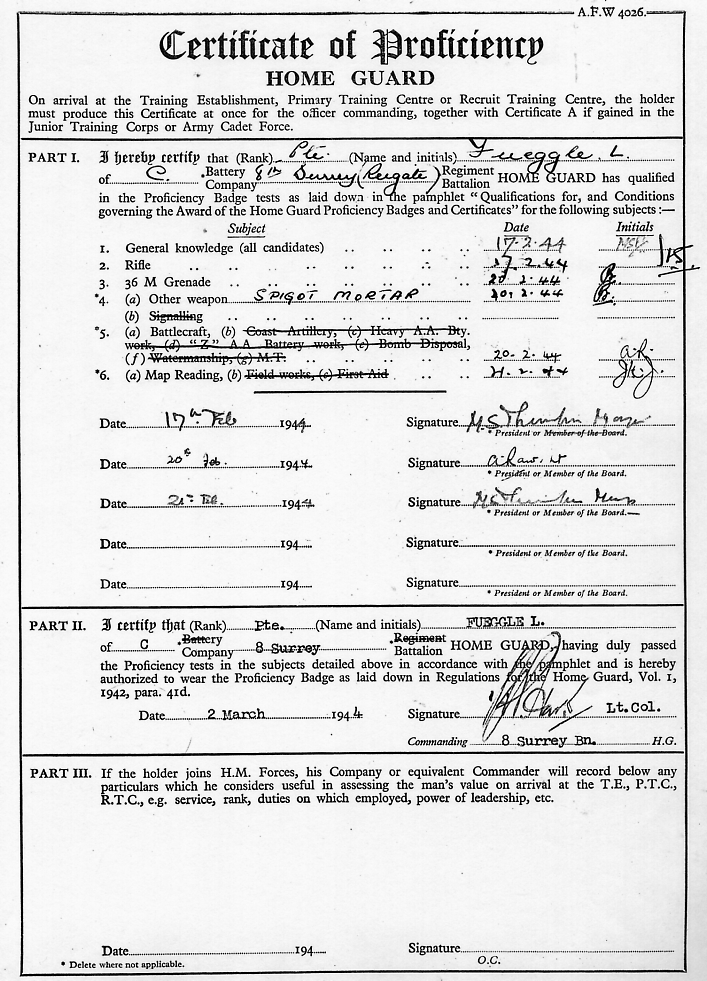 |
|
Certificate of Proficiency issued to Pat's father, Leonard Fueggle, who served in the Regate Home Guard.
The certificate is signed by Lt-Col R.Hake who was the Commander of the Borough of Reigate Home Guard.
|
| |
|
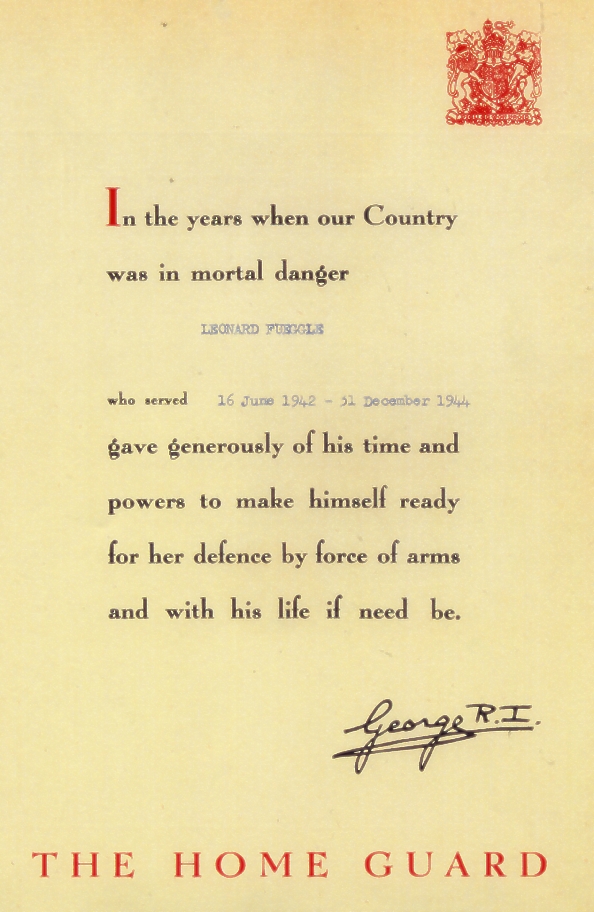 |
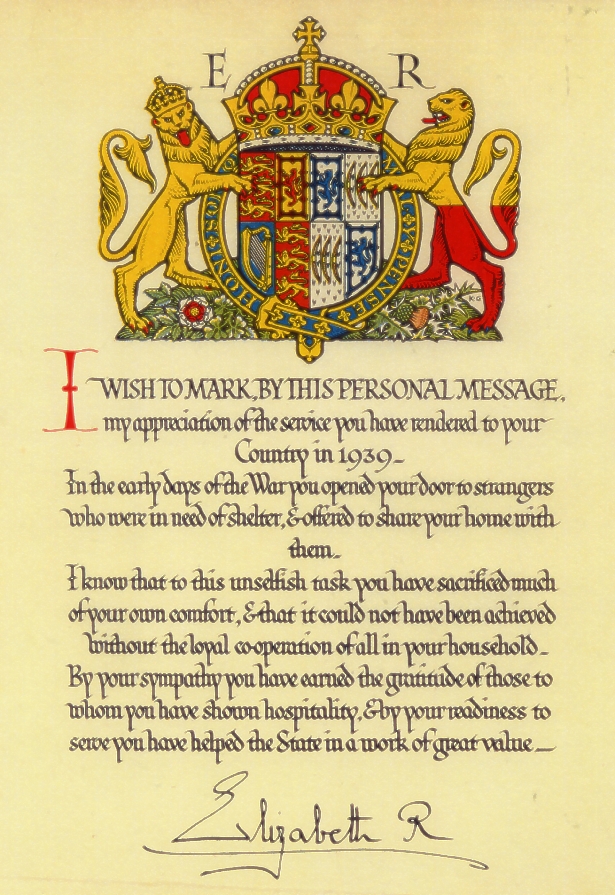 |
|
In appreciation of Pat's father's commitment to the Home Guard.
|
To Pat's mother in appreciation of her services to evacuees
|
| |
|
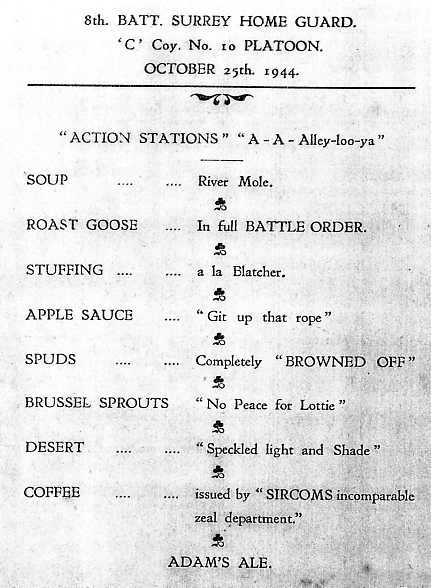
|

|
|
In September 1944 the announcement was made that the Home Guard would be stood down as from December of the year. This is the menu for what was presumably a farewell dinner organised by Pat's father's platoon
|
Received by Pat as a schoolgirl
Many thanks to Pat Hodnett for allowing sight of these documents
|
| |
|
Below is the same menu as above plus the toast list kindly sent in by Mr P. Brown. It contains signatures of many of those attending.
|
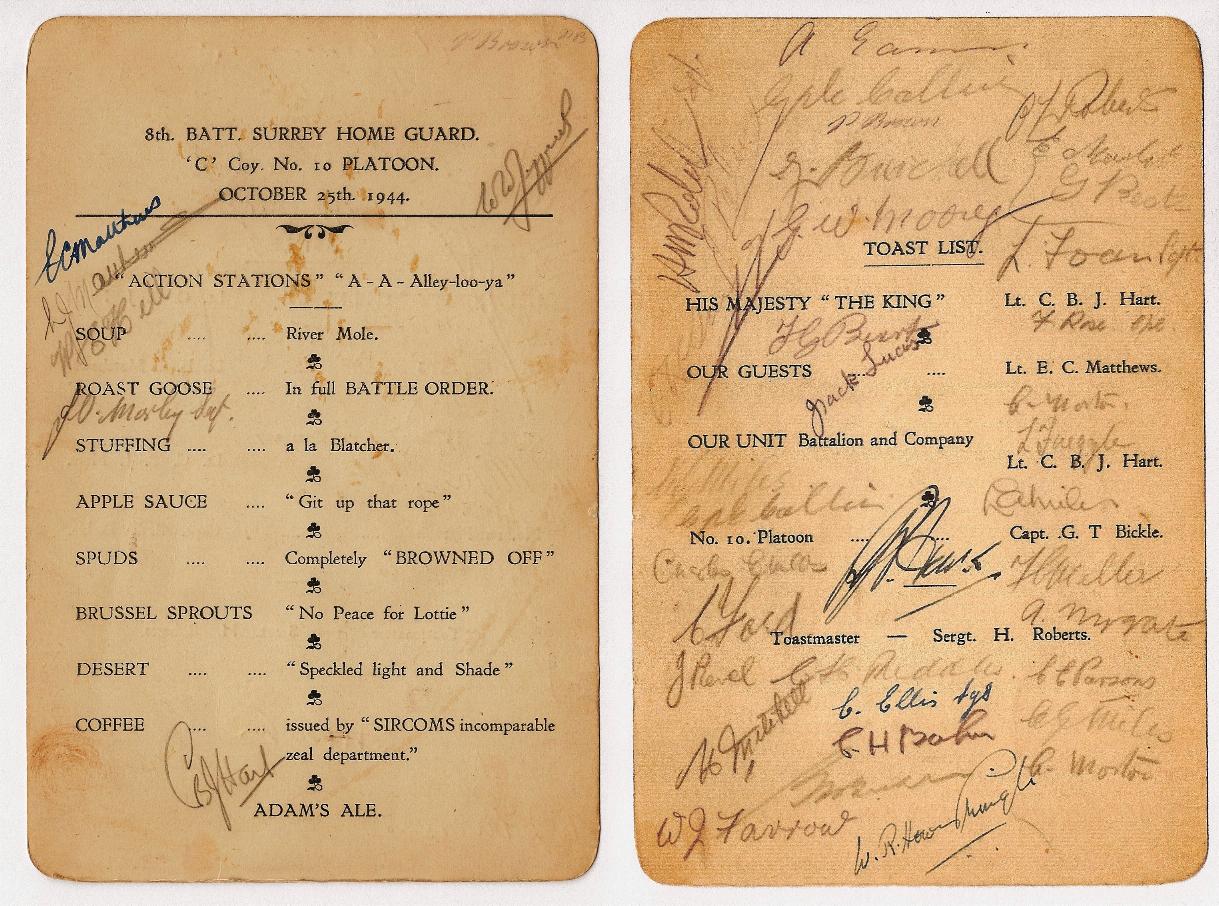 |
| |
|
Below is a menu for the 11th Platoon C Company, also from Mr P.Brown.
|
 |
| |
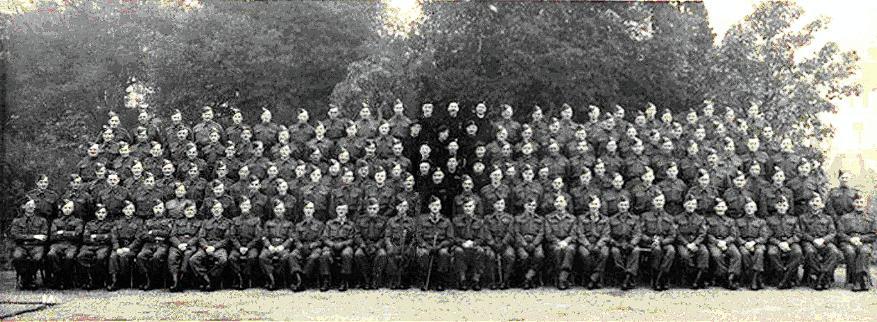
27
|
|
8th Surrey Battalion C Company Home Guard taken in the then open car park between the Majestic Cinema amd Church Street Reigate on the occasion of stand down in December 1944. Photo courtesy Mr P. Brown.
|
| |
|
Many thanks to Mr Brown for allowing the menus and photo to appear
above.
|
| |
| |
|
|
Email from Robin Lane October 2011
My father (Roy Henry Lane - who passed away only last week) was in the Home Guard 8th battalion C company between 1941 and 1942 - see attached ID card. He was only 16 when he joined but may have joined with his father (Horace Harold Lane - ex WWI army sergeant) at the same time. They then lived in Meadow Way, Woodhatch. |
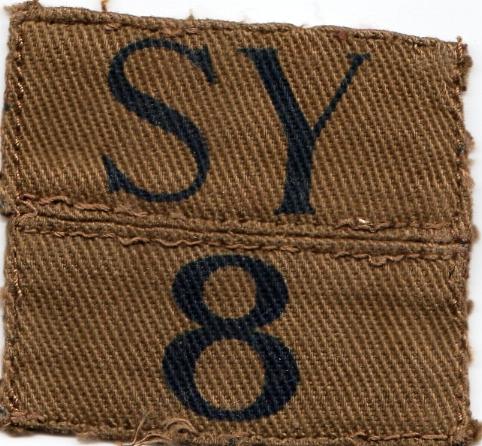
I do not have any other photos of him in Home Guard uniform but do have a copy of his service certificate and 2 badges. He joined the RNPS in late 1942 - based mainly at Sheerness/Rochester thereafter.
|
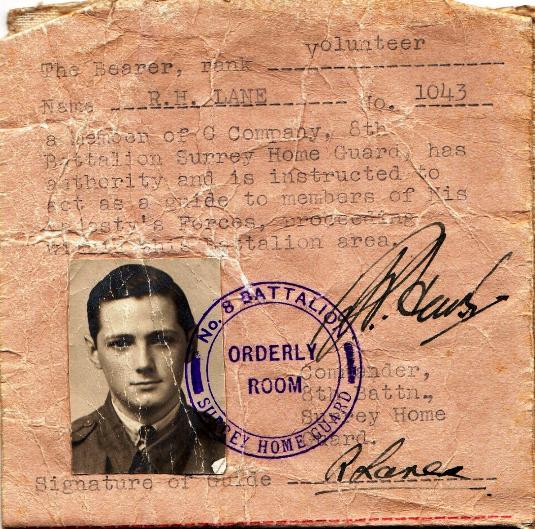 |
| |
|
|
Below are Corporal Lane's grenade throwing course certificate
and service commendation. He was in the same company of 8th battalion as Mr Brown's
photo above.
|
 |
| |
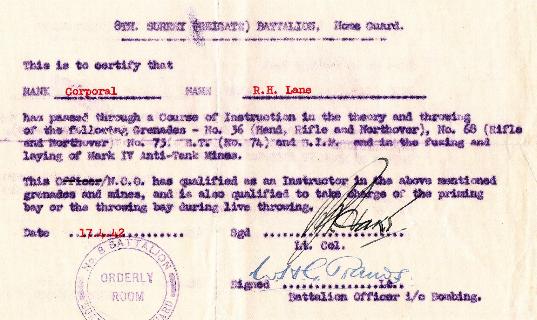 |
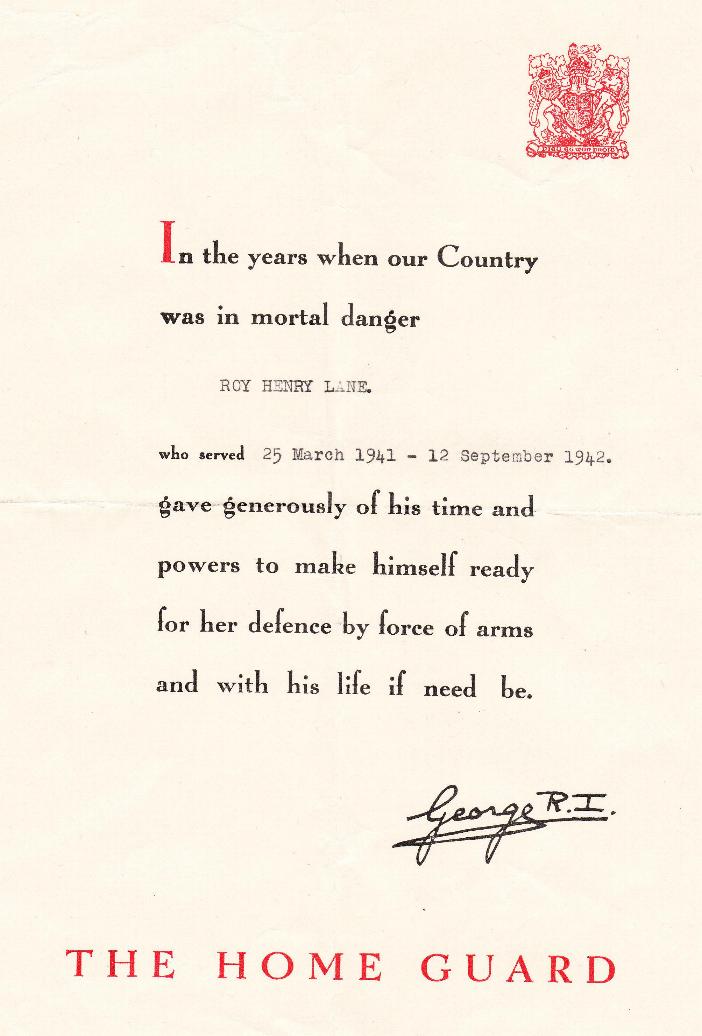 |
|
Grateful thanks to Robin Lane for providing these images.
|
|
| |
|
| |
|
| Parade |
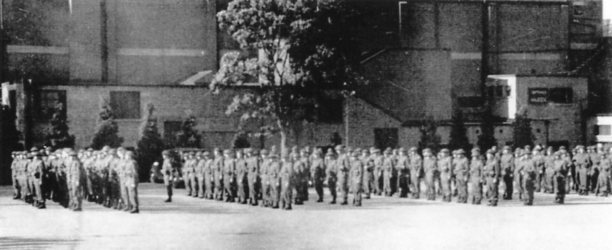
28
|
|
The stand down parade at Reigate's Majestic car park was referred to in photo 27 above. These photos of a Home Guard parade are also in the Majestic car park but are probably from a different occasion
|
| |
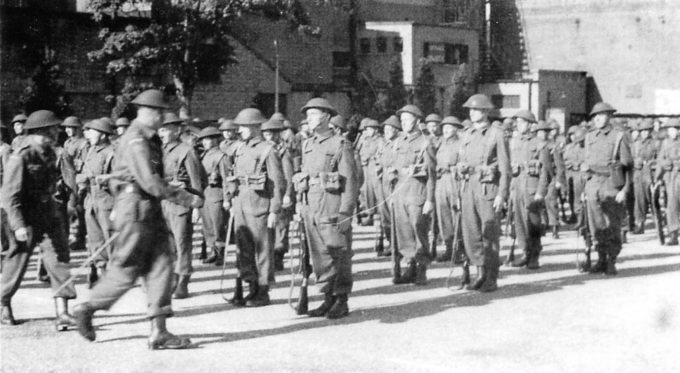
29
|
|
Inspection in progress
|
| |
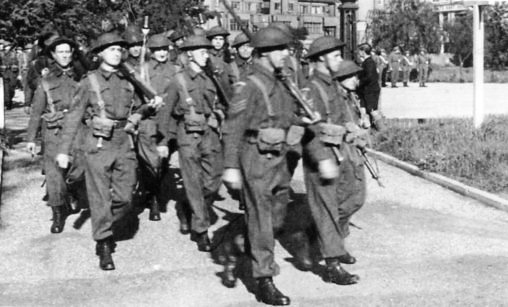
30
|
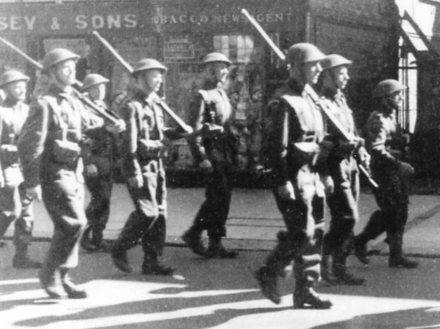 31` 31`
|
|
Leaving the car park. Bernard Henry Yates is 4th
from left.
|
Marching past Hussey's newsagents in Bell Street,
Reigate. Bernard Henry Yates is 4th from left.
|
| |
|
|
NOTE: (The source of these four above photos has been lost.
|
| |
|
| |
|
|
Dewar
|
|
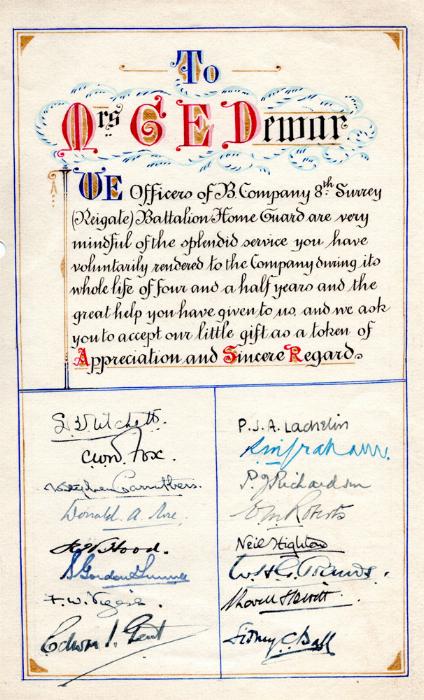
Mr Robin Keightley of Lowestoft, Suffolk, sent this item,
saying:
'I was searching through some old family documents and stumbled across the attached illuminated address to Mrs C. E. Dewar from the Officers of B Company 8th Surrey (Reigate) Battalion of the Home guards.
Mrs Dewar's husband Lt A Dewar was I understand the North Divisional Leader.
On the death of Lt Dewar his wife was to eventually marry my uncle, hence the papers being in my possession.
....'
The document is of great interest and I'm pleased to add it
to this page. Further information was kindly supplied by Mr Sean Hawkins as follows:
This must connect with Lieut. A.W.G.Dewar who was Company Commander of "B" Company, Home Guard, Reigate.
This particular Company was originally known as the Reigate North Platoon of the Local Defence Volunteers – as the Home Guard was called up to July 1940 - and under Dewar's command they manned a road block at Crossways, at the top of Reigate Hill.
By 1941 "B" Company was the largest in the Borough with 14 officers and 291 "other ranks".
A wartime directory records that Alex. W.G. Dewar was living at 1 Doran Gardens, Doran Drive, Redhill.
Many thanks to Mr Keightley and Mr Hawkins.-
AJM
|
| |
|
| |
|
|
And finally
|
|
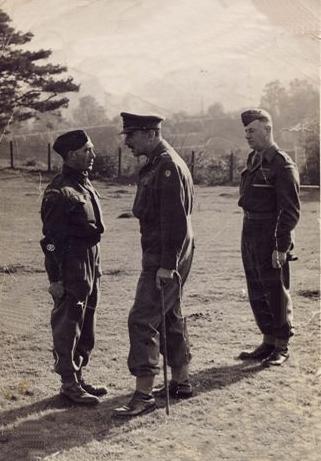 |
| 32 |
The man on the left is Frank Robinson
who was born in 1909 at 84, St John's Road Redhill and lived
there until December 1992.
He worked for the railway as a Railway Porter/Driver and was in
the Surrey Home Guard, possibly in a railway platoon. Although the body language in this
photograph might suggest that Frank was receiving a reprimand from the officer it may be
that the opposite is true, for Frank's daughter
was told by an elderly family member that he and a civilian had
managed to stop a rail truck or train, and the reason that the picture was taken was
that he was receiving a commendation. The back of the photo stamped 'Southern
Railway photograph', and is dated 1943. Frank's daughter has nothing to
confirm this
Frank was known locally as Robo Robinson.
(Photo courtesy Valerie Morse and Vanessa Tayler)
|
| |
|
|
Grateful thanks to all those who have provided photos, documents, information and identifications for the above.
|
|
|

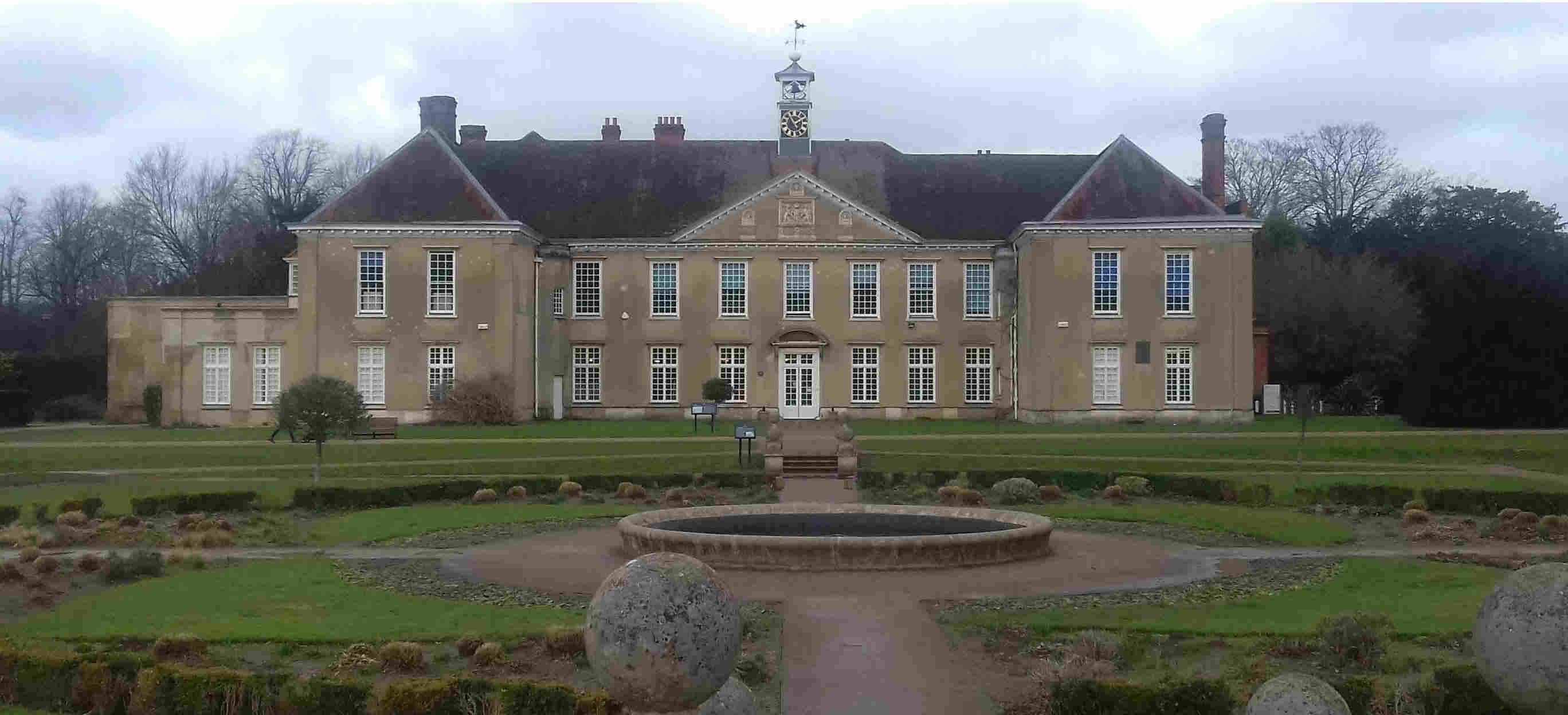




 31`
31`